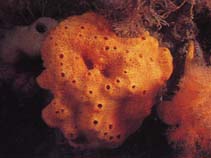Halichondria bowerbanki Burton, 1930
Bowerbanks halichondriaWarning: DOMDocument::load(): SSL operation failed with code 1. OpenSSL Error messages: error:140770FC:SSL routines:SSL23_GET_SERVER_HELLO:unknown protocol in C:\Apache24\htdocs\includes\SpeciesSummary.lib.php on line 1236
Warning: DOMDocument::load(): Failed to enable crypto in C:\Apache24\htdocs\includes\SpeciesSummary.lib.php on line 1236
Warning: DOMDocument::load(https://sealifebase.nrm.se/webservice/AquaMaps/getAMap.php?genus=Halichondria&species=bowerbanki): failed to open stream: operation failed in C:\Apache24\htdocs\includes\SpeciesSummary.lib.php on line 1236
Warning: DOMDocument::load(): I/O warning : failed to load external entity "https://sealifebase.nrm.se/webservice/AquaMaps/getAMap.php?genus=Halichondria&species=bowerbanki" in C:\Apache24\htdocs\includes\SpeciesSummary.lib.php on line 1236
Classification / Names Common names | Synonyms | CoL | ITIS | WoRMS
| Suberitida | Halichondriidae
Environment: milieu / climate zone / depth range / distribution range Ökologie
; tiefenbereich 0 - 90 m (Ref. 123733). Temperate; 79°N - 17°N, 128°E - 28°E
Verbreitung Länder | FAO Gebiete | Ecosystems | Vorkommen | Einführungen
Arctic, Pacific Ocean and Atlantic Ocean: from Korea, north to Svalbard, south to Mauritania and east to Bulgaria, Black Sea.
Length at first maturity / Size / Gewicht / Alter
Maturity: Lm ? range ? - ? cm
Present on rocky surfaces in the shallow subtidal, with occasional intertidal specimens under overhanging rocks. Lives in wave-sheltered, sediment-rich environments. Usually grows intertwined with hydroids and algae and may be common in estuaries. May occur in areas sheltered from strong tidal flow through to tidal sounds (Ref. 123733). Main food and feeding type based on another species of the same genus; to be replaced with a better reference (Refs. 96418, 96471).
Life cycle and mating behavior Geschlechtsreife | Fortpflanzung | Ablaichen | Eier | Fecundity | Larven
Members of the class Demospongiae are hermaphroditic. Life cycle: The zygote develops into parenchymella larva (free-swimming) before settling down on a substrate where it grows into a young sponge.
Hauptreferenz
Referenzen | Koordinator | Partner
Harms, J. 1993. (Ref. 2711)
IUCN Rote Liste Status (Ref. 130435)
CITES Status (Ref. 108899)
Not Evaluated
CMS (Ref. 116361)
Not Evaluated
Bedrohung für Menschen
Nutzung durch Menschen
| FishSource |
Tools
Mehr Information
Alter/Größe
Wachstum
Länge-Gewicht
Länge-Länge
Morphologie
Larven
Dichte
Wachstum
Länge-Gewicht
Länge-Länge
Morphologie
Larven
Dichte
Internet Quellen
BHL | BOLD Systems | CISTI | DiscoverLife | FAO(Publication : search) | Fishipedia | GenBank (Genom, nucleotide) | GloBI | Gomexsi | Google Books | Google Scholar | Google | PubMed | Tree of Life | Wikipedia (Gehe zu, Suchen) | Zoological Record
Estimates based on models
Preiskategorie
(Ref. 80766):
Unknown.



